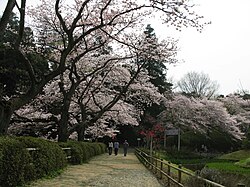Noda, Chiba
|
Noda 野田市 |
|||
|---|---|---|---|
| City | |||

Shimizu Park in Noda
|
|||
|
|||
 Location of Noda in Chiba Prefecture |
|||
| Coordinates: 35°57′N 139°52′E / 35.950°N 139.867°ECoordinates: 35°57′N 139°52′E / 35.950°N 139.867°E | |||
| Country | Japan | ||
| Region | Kantō | ||
| Prefecture | Chiba Prefecture | ||
| Government | |||
| • Mayor | Takashi Nemoto (since July 1992) | ||
| Area | |||
| • Total | 103.54 km2 (39.98 sq mi) | ||
| Population (April 2012) | |||
| • Total | 155,644 | ||
| • Density | 1,500/km2 (4,000/sq mi) | ||
| Time zone | Japan Standard Time (UTC+9) | ||
| -Tree | Japanese zelkova | ||
| - Flower | Azalea | ||
| - Bird | Skylark | ||
| Phone number | 04-7125-1111 | ||
| Address | 7-1 Tsuruhō, Noda-shi, Chiba-ken 278-8550 | ||
| Website | Noda City | ||
Noda (野田市 Noda-shi?) is a city located in far northwestern Chiba Prefecture, Japan.
As of April 2012, the city has an estimated population of 155,644 and a population density of 1500 persons per km². The total area is 103.54 km².
Noda is located in the far northwestern corner of Chiba Prefecture.
The area around Noda has been inhabited since prehistory, and archaeologists have found ancient shell middens in the area. During the late Heian period, the area was controlled by Kamakura Gongorō Kagemasa, and a succession of minor warlords during the Sengoku period. During the Edo period, Noda developed as a river port, post town on the pilgrimage road to , and a center for the production of soy sauce. Neighboring Sekiyado was controlled by the Late Hojo clan during the Sengoku period, and developed as a castle town under Sekiyado Domain, a feudal han under the Tokugawa shogunate.
After the Meiji Restoration, Noda and Sekiyado towns were created on April 1, 1889. Noda was elevated to city status on May 3, 1950.
On June 6, 2003, the town of Sekiyado (from Higashikatsushika District) was merged into Noda.
...
Wikipedia



